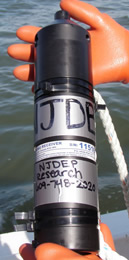
The Atlantic Sturgeon Acoustic Telemetry Monitoring Survey employs the use of acoustic telemetry technology to track the use of the Delaware Bay by Atlantic sturgeon and a variety of other fish species that have been surgically implanted with acoustic telemetry tags. The data collected through this survey are used by researchers and fisheries managers to better understand the spatial and temporal use of the Delaware estuary by endangered Atlantic sturgeon and to better inform the current base of knowledge in regards to coastwide migrations of sturgeon and other species of recreational, commercial, or ecological importance.
The Atlantic Sturgeon Acoustic Telemetry Monitoring Survey was initiated by the NJDEP Fish and Wildlife’s Bureau of Marine Fisheries (BMF) in 2012 in response to the Federal listing of Atlantic sturgeon on the endangered species list. It was determined that there was a lack of data and knowledge concerning the use of the Delaware estuary by Atlantic sturgeon. The goal of this survey is to fill these data gaps and help fisheries researchers make more informed management decisions when it comes to the protecting important habitats being used by all life history stages of Atlantic Sturgeon.
In order to accomplish this goal and fill knowledge gaps the BMF developed the Atlantic Sturgeon Acoustic Telemetry Monitoring Survey. This survey uses acoustic telemetry technology which involves listening for individually unique tags that have been implanted in a fish that can be actively transmitting for years (Basics of Acoustic Telemetry). The device that does the listening is an acoustic receiver. 19 total acoustic receivers are deployed in the lower half of the eastern Delaware Bay where they are anchored to the bay floor with buoys marking their locations. These receivers are typically deployed in March and retrieved in November, a time frame identified as when Atlantic sturgeon are most likely to be find in the lower Delaware estuary. As these sturgeon, or any acoustically tagged fish, mammal, or arthropod species, swim through the array their location and time of detection is logged by the receivers which are retrieved monthly by BMF staff to download this important data. Depending on water conditions the receivers have a .5km-1.5km detection radius allowing for near complete lower bay area coverage with the current 19 receiver array as deployed.

The Atlantic Sturgeon Acoustic Telemetry Monitoring Survey typically detects between 40,000 and 80,000 pings per year from between 250 and 400 individually tagged organisms. The majority of animals that are detected are Atlantic sturgeon. The highest amount of sturgeon detections typically occur in May which corresponds to their spring spawning migrations. Other species that have been detected include striped bass, tarpon, sand tiger sharks, sandbar sharks, horseshoe crabs, and stingrays. Fish that were tagged as far south as Florida (bull shark, tarpon, and black drum) have been detected in the array and many individual tags have been detected multiple years in a row. The data collected through the Atlantic Sturgeon Acoustic Telemetry Monitoring Survey is used by fisheries managers on a regional and coastwide basis in order to develop regulations that will protect this vulnerable species whose numbers have dwindled from an estimated 180,000 spawning females in the Delaware estuary pre-1890 to between 300 and 500 today. For more information on Atlantic management check out the Atlantic States Marine Fisheries Council’s website at, http://www.asmfc.org/species/atlantic-sturgeon.
Help New Jersey out,
REPORT A STURGEON SIGHTING!
Project Lead Contact Information/Designated Contact Person
Brian Neilan, Fisheries Biologist
Brian.Neilan@dep.nj.gov
609-748-2020
 Official Site of The State of New Jersey
Official Site of The State of New Jersey


